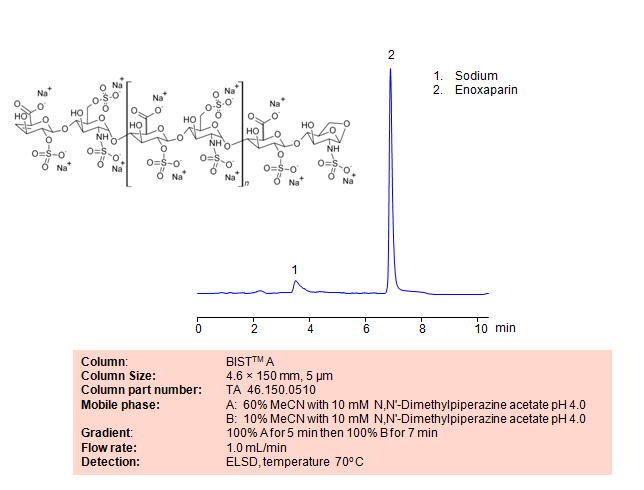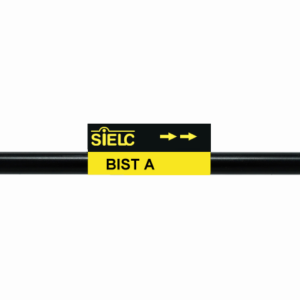Separation type: Bridge Ion Separation Technology, or BIST™
BIST Ionic Modifier Preparation

High Performance Liquid Chromatography (HPLC) Method for Analysis of Enoxaparin
Enoxaparin sodium is a popular anticoagulant used to treat deep vein thrombosis, pulmonary embolisms, and heart attacks. Using SIELC’s newly introduced BIST™ method, Enoxaparin sodium, which ionizes in water, can be retained on a negatively-charged, cation-exchange BIST™ A column. There are two keys to this retention method: 1) a multi-charged, positive buffer, such as N,N’-Dimethylpiperazine (DMP), which acts as a bridge, linking the negatively-charged Enoxaparin analytes to the negatively-charged column surface and 2) a mobile phase consisting mostly of organic solvent (such as MeCN) to minimize the formation of a solvation layer around the charged analytes. With a fairly simple 2-stage gradient, Enoxaparin and sodium can be separated and retained on a BIST™ A column. The gradient is necessary because of the extremely strong retention in BIST. Mobile Phase A, with its high-organic concentration, induces the initial Enoxaparin retention. But an isocratic MP with just MP A would result in extremely long retention times. By introducing a low-organic mobile phase, the solvation layer increases, reducing BIST interactions and the analyte is able to elute in an appropriate amount of time. This method is compatible with mass spectrometry (MS), evaporative light scattering detection (ELSD), charged aerosol detection (CAD).
| Column | BIST™ A, 4.6×150 mm, 5 µm, 100A |
| Mobile Phase | Gradient MeCN |
| Buffer | N,N’-Dimethylpiperazine acetate pH 4.0 |
| Flow Rate | 1.0 ml/min |
| Detection | ELSD, 70C |
| Class of Compounds | Drug, Anticoagulant |
| Analyzing Compounds | Enoxaparin |
Application Column
BIST A
BIST™ columns offer a unique and effective way to achieve separations that were traditionally challenging or even impossible with other HPLC columns. With the use of a special mobile phase, these ion exchange columns provide very strong retention for analytes with the same charge polarity as the stationary phase, unlocking new chromatography applications. What makes BIST™ columns stand out is their proprietary surface chemistry, which results in superior selectivity, resolution, and sensitivity. These columns offer a simple, efficient solution for a variety of analytical challenges, making them an excellent choice for researchers and analysts across many different fields. To learn more about the technology that powers BIST™ columns and to explore related applications, check out https://BIST.LC.
Select options




